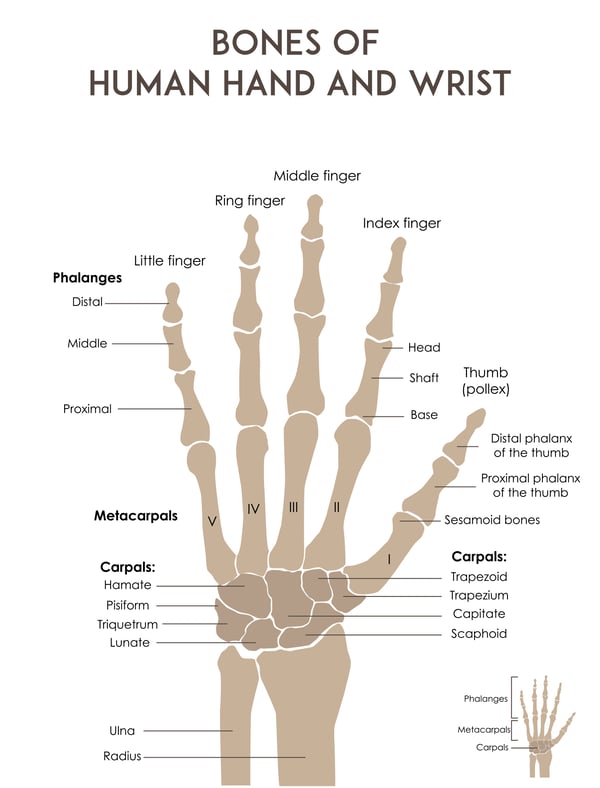Understanding Common Wrist Injuries: Causes, Severity, and Effective Treatment Plans

Licensed Physical Therapist, PT, DPT // EW Motion Therapy Liberty Park
Wrist injuries are prevalent and can range from mild discomfort to severe impairment, impacting daily activities. Understanding the types of wrist injuries, their causes, severity levels, and the most effective treatment plans is crucial for anyone seeking to maintain wrist health or recover from an injury. Physical therapy is often a vital step in rehabilitation and pain management - we love helping our clients at EW Motion Therapy recover from injuries and return to their favorite activities. You may decide that our physical therapy isn’t right for you, but through this comprehensive review, we aim to provide a deep understanding of common wrist injuries, helping you make well-informed decisions about their care and treatment.
Types of common wrist injuries
Severity levels
Before we discuss the most common wrist injuries, let’s review the levels of severity. Wrist injuries are typically categorized into three severity levels:
- Grade I (mild): Minor sprains, strains, or fractures without significant tissue damage.
- Grade II (moderate): More significant damage with partial ligament tears or non-displaced fractures.
- Grade III (severe): Complete ligament tears, displaced or complex fractures, or severe RSIs requiring immediate medical attention.
Proper diagnosis is critical for understanding the severity of a wrist injury. This often involves physical examinations, medical history reviews, and imaging tests such as X-rays, MRIs, or CT scans. These tools help determine the type and extent of the injury, guiding appropriate treatment plans.

Sprains and strains
Sprains and strains are among the most common wrist injuries. A sprain refers to the stretching or tearing of ligaments—the rugged bands of fibrous tissue connecting bones in a joint. Strains, conversely, involve muscles or tendons, the tissues connecting muscles to bones. These injuries often result from falls, sudden impacts, or twisting movements.
Causes and symptoms
Typical causes include sports injuries, falls on an outstretched hand, and repetitive stress. Symptoms include pain, swelling, bruising, and reduced range of motion. The severity can vary depending on the extent of the ligament or tendon damage.
Fractures
Wrist fractures involve a break or crack in one or more of the bones in the wrist, commonly the radius or scaphoid bones. They are often caused by high-impact injuries such as falls, sports accidents, or direct blows.
Types and indicators
Fractures can be simple, with the bone pieces aligned, or complex, where bones are misaligned or shattered. Symptoms include severe pain, swelling, tenderness, and an inability to move the wrist or bear weight.
Repetitive stress injuries
Repetitive stress injuries (RSIs), such as carpal tunnel syndrome and tendonitis, result from overuse or repetitive motion. They are common in individuals who perform repetitive tasks, such as typing or assembly line work.
Recognizing RSIs
Symptoms include pain, tingling, numbness, and weakness in the wrist and hand. These injuries develop gradually and can become chronic if not addressed.
Effective treatment plans for wrist injuries
Initial care: RICE method
The RICE method (Rest, Ice, Compression, Elevation) is often the first line of treatment for minor to moderate wrist injuries. It helps reduce swelling, alleviate pain, and speed up recovery.
Physical therapy for wrist rehabilitation
Physical therapy and targeted exercises are crucial for restoring strength, flexibility, and range of motion. These exercises should be tailored to the individual's injury and recovery stage.
Physical therapy plays a pivotal role in the rehabilitation process for wrist injuries. It not only aids in recovery but also helps reduce the risk of re-injury by strengthening and stabilizing the wrist joint. Let's delve into how physical therapy can effectively treat common wrist injuries.
Customized exercise programs
Physical therapists develop customized exercise programs tailored to the specific type and severity of the wrist injury. These exercises are designed to restore strength, improve flexibility, and increase the range of motion. They typically progress from gentle stretches to more strenuous exercises as the wrist heals.
Techniques and modalities
Physical therapists employ various techniques and modalities, such as ultrasound, electrical stimulation, and manual therapy. These methods can reduce pain, decrease inflammation, and promote tissue healing. Manual therapy, including massage and joint mobilization, can be particularly effective in increasing mobility and reducing stiffness in the wrist.
Key exercises
- Flexibility and stretching exercises: Flexibility exercises are crucial in the early stages of rehabilitation. Gentle stretches help maintain the range of motion and prevent stiffness. Examples include wrist flexor and extensor stretches, which involve gently bending the wrist forward and backward.
- Strengthening exercises: As the wrist heals, strengthening exercises become integral. These exercises include grip strengthening using a stress ball or rubber bands and wrist curls with light weights. Strengthening the muscles around the wrist helps support the joint and reduces the risk of future injuries.
- Proprioception and balance training: Proprioception exercises help regain the sense of the wrist's position and movement, which is often affected after an injury. Activities like balancing a ball on the back of the hand can effectively enhance proprioception.
Advanced physical therapy techniques
- Functional training: Functional training involves exercises that mimic daily activities or specific sports movements. This type of training ensures that the wrist can handle the stresses of everyday use and helps in a smoother transition back to daily activities or sports.
- Occupational therapy integration: In cases where wrist injuries affect daily activities like writing or typing, integrating occupational therapy with physical therapy can be beneficial. Occupational therapists can provide specific exercises and ergonomic advice to facilitate a safe return to these activities.
- Hand therapy certification: Some physical or occupational therapists have a specialty in hand therapy, and their credentials may be useful in your rehabilitation, especially for grade III injuries.
Physical therapy is a cornerstone of the rehabilitation process for wrist injuries. Physical therapy can significantly enhance recovery with customized exercise programs, advanced therapeutic techniques, and a focus on healing and prevention. Working closely with a physical therapist is critical to ensure the exercises and treatment plan are tailored to your needs and recovery goals. Remember, a comprehensive approach to rehabilitation, combining physical therapy with other treatment modalities, offers the best chance for a full and speedy recovery from wrist injuries.
Medical interventions
Medical interventions such as splinting, casting, or even surgery may be necessary in more severe cases. These treatments are typically reserved for complete ligament tears, complex fractures, or when conservative treatments have failed.
Pain management
Pain management, including over-the-counter pain relievers, prescription medications, or corticosteroid injections, can be an essential aspect of the treatment plan, particularly in managing chronic pain from RSIs.
Understanding common wrist injuries, their causes, severity, and effective treatment plans is essential for anyone dealing with wrist issues. Each type of injury requires a tailored approach to ensure optimal recovery, from sprains and strains to fractures and RSIs. Whether through the RICE method, rehabilitation exercises, medical interventions, or pain management, the right treatment plan can make a significant difference in the recovery process. Early diagnosis and appropriate care are crucial to preventing long-term complications and ensuring a swift return to daily activities.
Consulting with healthcare professionals is always recommended for those seeking more personalized advice or treatment. They can provide guidance based on your wrist injury’s specific nature and individual needs. A physical therapist is beneficial for rehabilitation and a specialized exercise program - we love helping our clients do this daily at EW Motion Therapy. If you’re curious about what else physical therapy can do for your recovery, click the button below to download our answers to 20 frequently asked questions.


